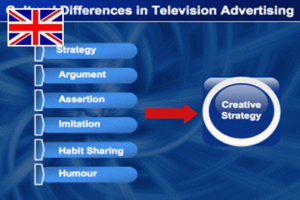
 Cultural Differences in Television Advertising Part 5
Cultural Differences in Television Advertising Part 5CREATIVE STRATEGY 1)
Another aspect that has frequently been looked at is the overall communication or creative strategy that is used in advertising. One frequently used measurement system analyses
· if the advert presented in the form of a lecture, with a narrator speaking about the product (typical of direct sales commercials),
· or if a “story” or drama is created in the commercial. This distinction was originally developed by Wells (1988) and later adopted and expanded by Deighton, Romer and McQueen (1989).
| Message elements | ||||
| Wells | Deighton | Narration | Character | Plot |
| Lecture | Yes | No | No | |
| Drama and Lecture | Demonstration | Yes | No | Yes |
| Story | Yes | Yes | Yes | |
| Drama | Drama | Yes | Yes | Yes |
Looking at the communication style used,
A slightly different flavour of creative strategy research, and more differentiated than the above, focuses on a variety of possible creative strategies that are frequently used in commercials. Most dominantly used are Simon’s Creative Strategies (1971). Martenson (1987), researching advertising in the US and Sweden, defined the strategies as follows:
| Strategy | Description |
| Information | Presentation of unadorned facts, without explanation or argument, merely “news about” the product concerned |
| Argument | Relating of facts (reasons why) in some detail to the desired purchase; logical “playing on established desires” in presenting “excuses” to buy |
| Motivation with psychological appeals | Explicit statement of how the product will benefit the consumer; use of emotions and appeals to self-interest in creating desires not previously readily apparent; interpretation of facts in an “especially for you” framework |
| Repeated assertion | Hard-selling repetition of one basic piece of information, often a generality, unsupported by factual proof. |
| Command | A “non-logical” reminder (either hard-sell or soft-sell) to predispose audience favourably; maybe reinforced by an authoritative figure |
| Brand familiarisation | Friendly, conversational feel, few or no “selling facts”, but suggestion of loyalty to and “trustworthiness” of the advertiser, keeps brand name before the public. |
| Symbolic assertion | Subtle presentation of a single piece of information, links the product to a place, event, person or symbol (any positive connotation); sales pitch usually not explicit, copy usually minimal, and product, in general, not “featured”. |
| Imitation | Testimonial, by a celebrity, by a “hidden camera” participant or by individual(s) unknown but with whom readers can readily identify (or whom they respect because of specified characteristics). |
| Obligation | Free offer of a gift or information or a touching sentiment, some attempt to make the reader feel grateful. |
| Habit sharing | Offer of a sample or reduced price to initiate a “regular practice or routine”; product usually featured. |
This method again is clearly more differentiated, and allows for a greater variety of creative styles to be analysed than the lecture/drama method. It is however quite limited in its approach and usability to analyse the interaction between values and advertising, as it focuses more on an additional preference for a certain creative style or styles in a country. It is however well suited for that, and possibly a good tool for a more descriptive research than pure value centred research.
Again, this method makes use of communication style and the use of linguistic styles, such as a preference for indirect and direct speech, however the link is less clearly visible than with the lecture/drama method.
Another stylistic or creative method that is frequently referred to and researched is the use of humour in advertising. This stands out somewhat, as it doesn’t represent a full creative style, and is not linked directly within the area of information cue or appeals research.
As can be seen from the above examples of research instruments used, the focus of research into (cross-cultural) advertising can be radically different, though related. Research into appeals is evidently the most broadly focused research, whereas information cues and strategy research takes a far narrower, however more explicit, focus. All of theses research foci make a useful contribution to identify more clearly how advertising is influenced by culture, and if used in combination, have the potential to provide an extremely powerful analysis of advertising practice.
Prof. C.J.M. Beniers
NL Zoetermeer
15-01-2013
About Professor C.J.M. Beniers
Prof. C.J.M. Beniers is a well known authority in the field of modern and international communication techniques. He developed the Six-Component-Model. This model enables companies, institutions and politicians to communicate and negotiate with counterparts from all over the world successfully. His career began as international manager at Philips and later he earned his doctorate as professor in communication. He has more than 35 years experience as manager and management trainer. Thus he knows both sides – theory and praxis – very well. As scientist, Prof. Beniers conducts frequently research in the field of intercultural communication. The results of his interesting research can be found in news articles, free pod casts, audio books and his E-books such as “Bridging The Cultural Gap.” Here, modern managers learn how to prepare for business meetings with people from different cultures; they acquire the techniques and tools to handle situations in times of crises successfully, master intercultural barriers, country-specific communication patterns, looking into personal cultural values & systems. Knowing all this, men can prevent cultural misunderstandings and misinterpretations – not only in business but also in private life.
Contact:
Prof. C.J.M. Beniers
Amaliaplaats 2
2713 BJ Zoetermeer The Netherlands
Telefone: +31 (0) 79 – 3 19 03 81 Mobile: +31 (0) 6 2 061 8494
Email: info@beniers-consultancy.com
Website: www.www.beniers-consultancy.com